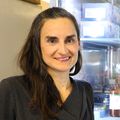A collaboration among Oregon Health & Science University and three other universities has produced mathematical models that could begin to unlock how groups of cells will respond to various cancer therapy combinations.

The findings, published today in the journal Cell, have broad implications across cancer-related specialties, giving researchers the keys to developing digital models designed to test and predict cell behavior.
"That's the long-term goal," said Laura Heiser, Ph.D., vice chair of biomedical engineering, OHSU School of Medicine, and associate director of complex systems modeling in the Cancer Early Detection Advanced Research Center program, OHSU Knight Cancer Institute.
"This research gives us a tool to begin to predict multicellular behavior. We're not there yet, but it puts us firmly on the road to being able to identify treatment combinations predicted to work best across cancer types, enabling development of novel treatment strategies."
Being able to do this, and do it as soon as possible, is critical for patients with cancer. Customized treatments, also called personalized or precision medicine, deliver better results, fewer side effects and hopes for improving clinical outcomes.

Heiser and Young Hwan Chang, Ph.D., associate professor of biomedical engineering, School of Medicine, and Knight Cancer Institute Interim Director Lisa Coussens, Ph.D., collaborated with researchers from Indiana University, University of Maryland and Johns Hopkins University. In all, four OHSU faculty members and two graduate student trainees took part in the research.
A Grassroots Effort
The effort began in 2020, when Heiser and Chang were conducting research into mechanisms of therapeutic resistance in breast cancer and began collaborating with Paul Macklin, Ph.D. A researcher from Indiana University, Macklin is the lead developer of PhysiCell, a software designed to create computational models of cells and tissues.
Macklin already had ongoing collaborations with Elana Fertig, Ph.D., from University of Maryland, who was focused on pancreatic cancer, and Johns Hopkins University's Genevieve Stein-O'Brien, Ph.D., who was researching brain development. In other studies, Fertig collaborated with Coussens to understand epigenetic mechanisms impacting therapy response in breast cancer regulated by macrophages, a type of immune cell.
Thanks to philanthropic and National Institutes of Health funding, the multi-institutional group of scientists began collaborating to harness the various scientific approaches across their five labs.
For the last two years, they have been meeting every Friday to present their findings and share updates. Their goal? To develop rational rules based on significant biologic responses, which could then inform mathematical prediction models for therapy responses.






